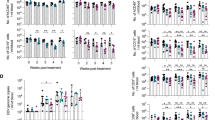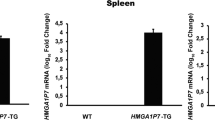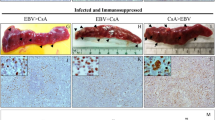Abstract
The very early stages of the human B-cell differentiation pathway are poorly understood, primarily because of the lack of appropriate permanent cell lines. Epstein–Barr virus (EBV) is a putative human oncogenic virus which transforms human B cells in vitro into continuously proliferating cells1. It has been believed that EBV transforms mature B cells2,3 but recently, transformation of immature pre-B-cell lines has been reported4–6, suggesting that EBV might also transform cells much earlier in the B-cell lineage. We report here the establishment of cell lines transformed by EBV at various stages of the B-cell differentiation pathway. Interestingly, two lines showed the complete absence of immunoglobulin synthesis and the lack of immunoglobulin gene rearrangement despite containing EBV genome and surface markers of B cells. Our results indicate that EBV can infect and tranform cells of the B lymphocyte lineage even before immunoglobulin gene rearrangement.
This is a preview of subscription content, access via your institution
Access options
Subscribe to this journal
Receive 51 print issues and online access
$199.00 per year
only $3.90 per issue
Buy this article
- Purchase on Springer Link
- Instant access to full article PDF
Prices may be subject to local taxes which are calculated during checkout
Similar content being viewed by others
References
Gerber, P., Whang-Peng, J. & Monroe, J. H. Proc. natn. Acad. Sci. U.S.A. 63, 740–747 (1969).
Rosen, A., Gergely, P., Jondal, M. & Klein, G. Nature 267, 52–54 (1977).
Yoshie, O., Tada, K. & Ono, Y. Tohoku J. exp. Med. 132, 397–403(1980).
Fu, S. M., Hurley, J. N., McCune, J. M., Kunkel, H. G. & Good, R. A. J. exp. Med. 152, 1519–1526 (1980).
Tsuchiya, S. et al. Tohoku J. exp. Med. 140, 133–144 (1983).
Hansson, M., Kerstin, F. & Ernberg, I. J. exp. Med. 158, 616–622 (1983).
Miller, G. & Lipman, M. Proc. natn. Acad. Sci. U.S.A. 70, 190–194 (1973).
Tsuchiya, S., Konno, T., Tada, K. & Ono, Y. Scand. J. Immun. 11, 155–162 (1980).
Korsmeyer, S. J. et al. Proc. natn. Acad. Sci. U.S.A. 78, 7096–7100 (1981).
Siden, E. J., Alt, F. W., Shinefeld, L., Sato, V. & Balitmore, D. Proc. natn. Acad. Sci. U.S.A. 78, 1823–1827 (1981).
Levitt, D. & Cooper, M. Cell 19, 617–625 (1980).
Loor, F., Forni, L. & Pernis, B. Eur. J. Immun. 2, 203–210 (1972).
Siden, E. J., Baltimore, D., Clark, D. & Rosenberg, N. E. Cell 16, 389–396 (1979).
Alt, F., Rosenberg, N., Lewis, S., Thomas, E. & Baltimore, D. Cell 27, 381–390 (1981).
Hass, I. G. & Wabl, M. Nature 306, 387–389 (1983).
Reedman, B. M. & Klein, G. Int. J. Cancer 11, 499–520 (1973).
Jondal, M. & Klein, G. J. exp. Med. 138, 1365–1378 (1973).
Greaves, M. F., Brown, G. & Rickinson, A. B. Clin. Immun. Immunopath. 3, 514–524 (1975).
Vogler, L. B. et al. Nature 290, 339–341 (1981).
Tonegawa, S. Nature 302, 575–581 (1983).
Honjo, T. A. Rev. Immun. 1, 499–528 (1983).
Takahashi, N., Nakai, S. & Honjo, T. Nucleic Acids Res. 8, 5983–5991 (1980).
Wabl, M. & Steinberg, C. Proc. natn. Acad. Sci. U.S.A. 79, 6976–6978 (1982).
Platts-Mills, T. A. & Ishizaka, K. J. Immun. 114, 1058–1065 (1975).
Kumagai, K., Abo, T., Sekizawa, T. & Sasaki, M. J. Immun. 115, 982–988 (1975).
Tachibana, T. & Ishikawa, M. Jap. J. exp. Med. 43, 227–235 (1973).
Ritz, J., Pesando, J. M., Notis-McConary, J., Lazarus, H. & Schlossman, S. F. Nature 283, 583–585 (1980).
Tofen, H. R. & Smith, R. G. Clin. exp. Immun. 27, 292–298 (1977).
Laemmli, U. K. Nature 227, 680–685 (1970).
Yaoita, Y. & Honjo, T. Nature 297, 697–699 (1982).
Southern, E. M. J. molec. Biol. 98, 503–517 (1975).
Rigby, P. W. G., Dichmann, C., Rhodes, C. & Berg, P. J. molec. Biol. 113, 237–251 (1977).
Author information
Authors and Affiliations
Rights and permissions
About this article
Cite this article
Katamine, S., Otsu, M., Tada, K. et al. Epstein–Barr virus transforms precursor B cells even before immunoglobulin gene rearrangements. Nature 309, 369–372 (1984). https://doi.org/10.1038/309369a0
Received:
Accepted:
Issue Date:
DOI: https://doi.org/10.1038/309369a0
This article is cited by
-
Epstein–Barr virus-positive diffuse large B-cell lymphoma following acute myeloid leukemia: a common clonal origin indicated by chromosomal translocation t(3;4)(p25;q21)
International Journal of Hematology (2015)
-
Construction of Japanese BAC library Yamato-2 (JY2): a set of 330K clone resources of damage-minimized DNA taken from a genetically established Japanese individual
Human Cell (2011)
-
Hodgkin's disease and anaplastic large cell lymphoma revisited
Journal of Biomedical Science (1996)
-
Role of the CD21 antigen in lymphocyte transformation by Epstein‐Barr virus
Immunology & Cell Biology (1988)
-
Abnormalities in DNA rearrangements of immunoglobulin gene loci in precursor B cells derived from X-linked agammaglobulinemia patient and a severe combined immunodeficiency patient
Immunogenetics (1988)
Comments
By submitting a comment you agree to abide by our Terms and Community Guidelines. If you find something abusive or that does not comply with our terms or guidelines please flag it as inappropriate.



